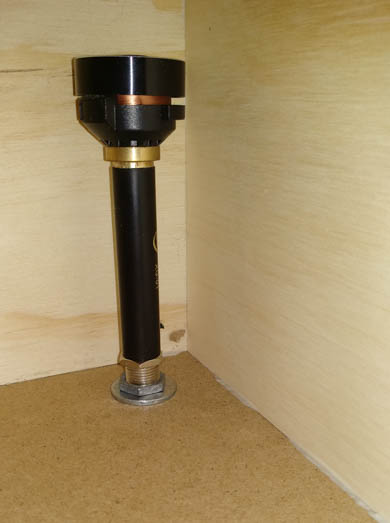What's inside a cajon depends on the type of cajon and the preferences of the cajon maker. In many cajons you will find snare mechanisms, structural components and sound hole reinforcements. In some cajons you will find manufacturer information, small bells, bungees, piezoelectric microphones or bass enhancing foam or cardboard. Because there are no 'rules of cajon building' there's a fair amount of variation. This page covers the features that you are most likely to encounter.
Peruvian Cajons
Usually there is nothing but air inside a traditional Peruvian cajon. Often the box is put together with joints so strong and wood thick enough that corner braces or other structural supports are not needed or are small and localized. Typical Peruvian cajons do not have snares.
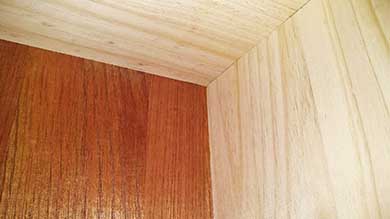
Inside a Peruvian cajon showing the dark brown tapa and the lighter colored, solid wood top and right side.
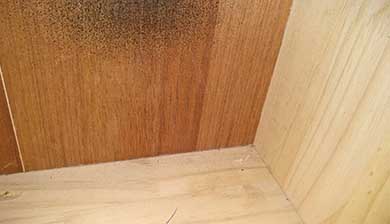
Inside a Peruvian cajon showing the tapa, the bottom and the right side. Note the small amounts of glue around the tapa indicating that this tapa is glued on dispite the presences of screws on the exterior.
Snare Wire Cajons
Snare wire cajons contain snare wire systems that produce a 'rattle' or 'buzz' when the cajon front, the tapa, is struck. They use the same tightly curled 'snare wires' which are found on the bottom of a drum kit snare drum. The snare wires are positioned to touch the inside of the cajon tapa along most of the wire length. There are many possible ways snare wires can be cut, arranged and positioned. Many snare wire mechanisms allow the snare sound to be muted or adjusted while the player is seated. Some are fixed and some can be removed. In some countries, snare wire cajons are the most common cajons found for sale by local cajon makers. This Pinterest board has photos of the many different kinds of cajon snare systems.
Fixed Snare Wires
Fixed snares are attached to the bracing or 'frame' of the cajon. They are the simplest to make but cannot be adjusted or muted.
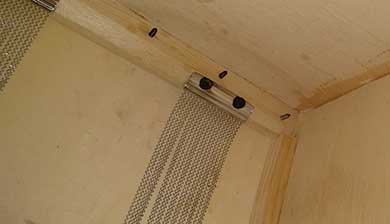
Fixed snare wires attached to the seat-tapa brace. The screws hold the top of the tapa in place.
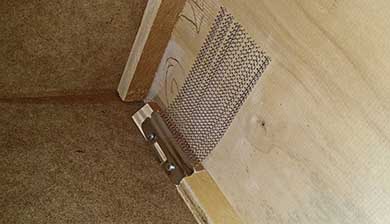
Fixed snare wires attached with screws to the side-tapa brace inside a cajon. The dark sides and top of this cajon are MDF or MDF-like material.
Stationary Bar Mounted Snare Wires
Bar mounted snare systems span the inside of the cajon from side to side, usually in the upper half of the cajon. Stationary bars may be fixed or removable depending on the cajon builder. The angle of the snare wires and the distance from the tapa is carefully determined by the builder to maximize the snare sound. If the bar is removable the user must get off the cajon to reach inside to take it out.
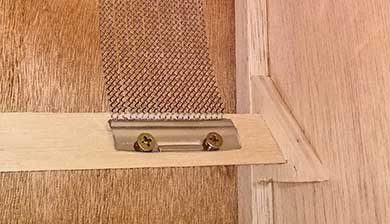
Non-adjustable, fixed bar stationary snare wire system. This bar cannot be removed. Note the shiny tapa, this indicates that the inside of this tapa has been treated with some sort of 'finish', perhaps polyurethane. Many cajons have untreated tapa backs.
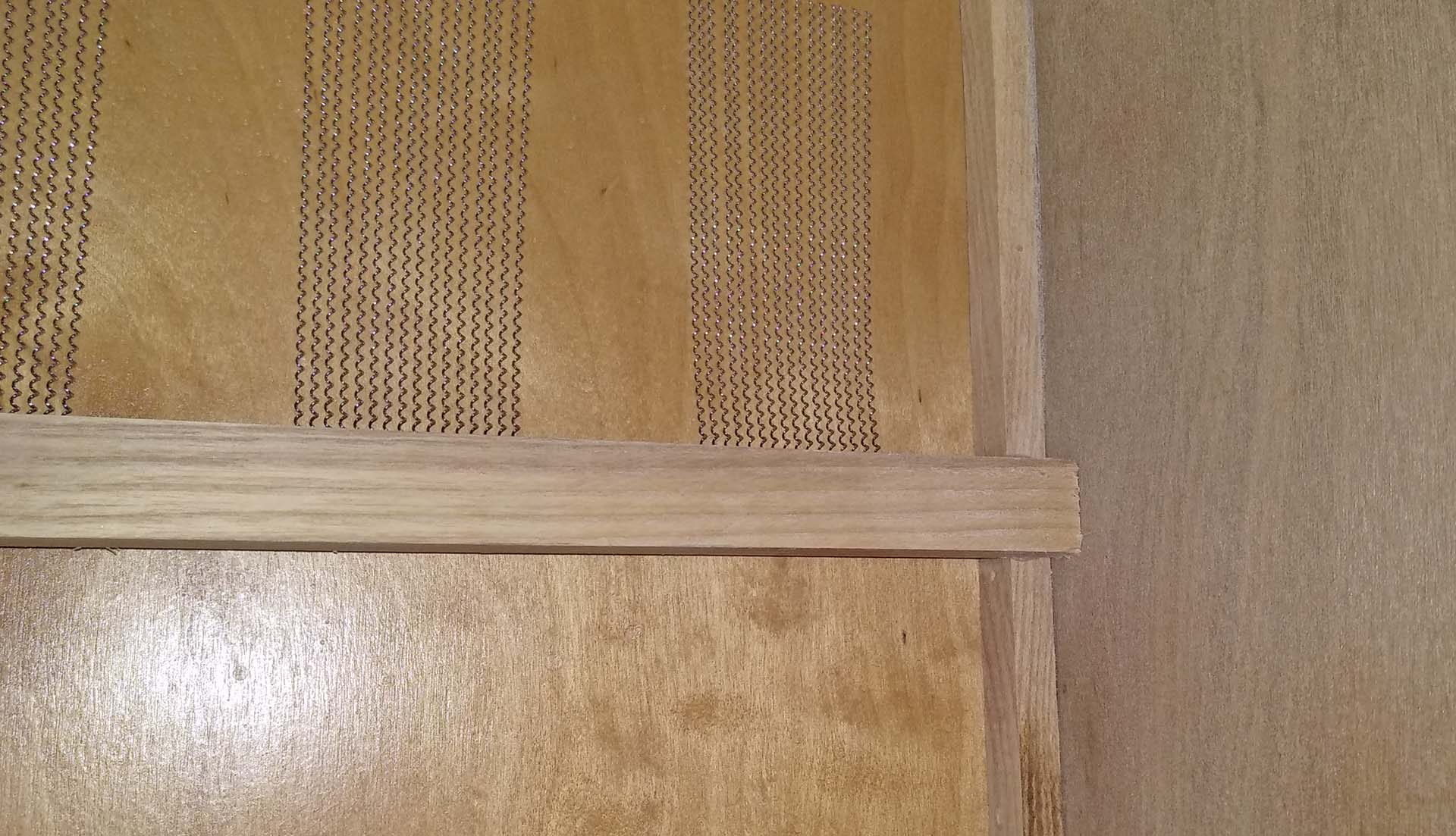
Fixed bar snare-wire system with 4 snare wire collectives. This cajon should have a lot of snare sound. Note the lack of large pores on the tapa and the presence of large wood pores on the sides of the cajon.
Adjustable Bar Mounted Snare Wires
Adjustable bar cajons usually present with a knob or lever on the outside of the cajon near the tapa. This allows the snare sound to be adjusted or even muted completely while the cajon player is seated on the cajon. These mechanisms are somewhat complicated and are most commonly made by local cajon builders. Often their designs are unique.

Adjustable bar snare mechanism found in JC Percussion cajons made in Bogota Colombia
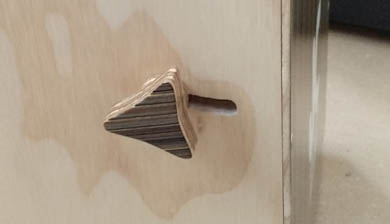
This knob slides to adjusting the snare wires. In this design when the knob is fully back the snare is off, forward the snare is on. Tightening the knob locks the mechanism in place. Other builders make systems with rotating knobs.
Board mounted snare wires
Board mounted snare wires can be removed to eliminate the snare sound. The user must get off the cajon to remove the board through the sound hole.
Snare Wire Location
When you look in a snare wire cajon you will most likely see the snare wires pressed against the tapa below the seat. However, there are exceptions and you should look at the full length of the tapa.
-
When looking at a snare wire system try to evalute:
- If you can adjust the amount of snare,
- how easy it is to adjust, and
- if the snare can be completely muted or removed.
Flamenco Cajons
Flamenco cajons typically have 2 to 10 guitar strings vertically arranged to touch the the full length of the inside tapa. Flamenco cajons have some kind of mechanism to adjust the tension of the guitar strings. Tighter strings produce less buzz. Some cajon makers use beaded wires or curly snare type wire instead of guitar strings. In most designs the user cannot adjust the string tension while seated on the cajon.
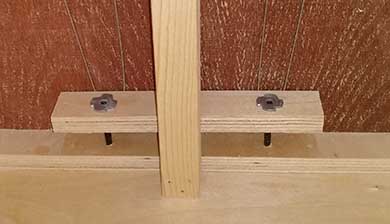
Simple mechanism inside a flamenco cajon at the base of the tapa to adjust the tension of the strings. As the screws are turned the bar goes up or down which loosens or tightens the strings.
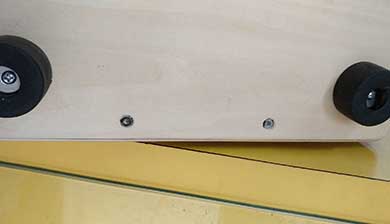
This is the same flamenco cajon as the previous photo. The two hex nuts on the bottom pull down or raise up the internal bar where the string are attached.
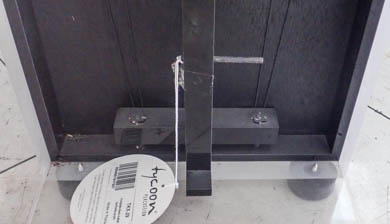
The acrylic boxes of Tycoon Percussion make it easy to see what's inside! The bar on the bottom tensions the guitar strings of this high tech flamenco cajon.
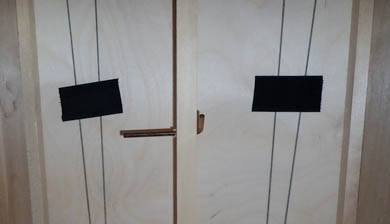
Flamenco style cajons often ship with a hex key to adjust tension of the strings. Here the hex key is stored in a hole in the seat post. Cloth tape or Velcro holds the strings against the tapa.
High end flamenco cajons sometimes use guitar tuning machines which allow strings to be individually tensioned. Many flamenco cajons also have a vertical wooden post supporting the seat near the tapa. The strings in flamenco cajons are often held against the tapa with Velcro or tape.
Plywood Panel Material
Identifying the species of wood used on a plywood panel from a photograph is impossible, even for an expert. But you will find some consistent looks. I will generalize here, so that we have some words to describe what we might see, but please remember, these are generalizations. Panels with large pores and no visible grain are often 'tropical hardwood plywood'. Often these are darkish with a 'mahogany' color, but ocassionally they are light colored. Light colored plywood with no visible pores may be birch plywood or it might be any of possibly hundreds of other species. However, Baltic birch is commonly used in commercial cajons. It tends to be very light with semi-prominent wavy summerwood. Light colored plywood without wavy summerwood, or with extremely dark summerwood we'll just call, "Other". It could be produced anywhere around the world.
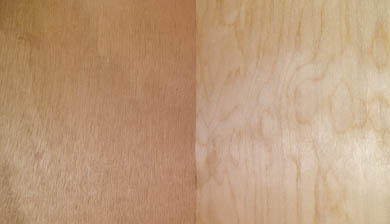
Tropical hardwood plywood on the left, note the large pores, reddish color and lack of wavy grain. Birch plywood on the right, note the wavy summerwood and the general lack of visible pores.
The boxes of many factory produced cajons appear to be either tropical hardwood plywood or birch plywood. Interesting that in some models if the box is birch the tapa is tropical hardwood plywood, or vice versa. Some manufactures vary models by using different plywoods for the box: tropical hardwood plywood on some models, birch plywood on others.
If the cajon is painted on the outside, look inside and you should be able to determine what the panels are made from - MDF, plywood, solid wood or edge-glued panels.
Bracing
A wood 'brace' is a piece of wood added to a corner joint to increase the strength of the joint. The need for bracing in a cajon will vary depending on the wood used, the type of joint, cajon dimensions and manufacturer preferences. One thing you cannot see when you look inside a cajon is the thickness of the side, top, bottom and back panels. The thickness of these panels and the strength of the panel material will determine if structural reinforcements are necessary. The thickness of the panels can also effect whether or not the tapa can be screwed on or if a edge widening brace is needed. In general the thicker and stronger the panels the less need there is for bracing.
There are 12 two-way corners in a typical cajon. A brace in any of these corners is technically a corner brace, but we'll reserve the term 'corner brace' for the 4 main corners that connect the 'main box' - the side, top and bottom panel corners. The other corners we'll refer to by the two adjoining panel names separated by a hyphen, example: seat-tapa brace. Please refer to the next photo for clarification.

This photo has the names for the common corner braces in a cajon. This Cajon Fly cajon from Medellin Colombia has a fixed bar snare wire system with Velcro holding down the ends of the snare wires.
Seat-Tapa Brace
The 'seat-tapa brace' is the corner brace between the seat panel and the tapa. In most cajons the seat panel is glued to the seat-tapa brace but the tapa is only screwed. A thinner seat panel will require a stronger seat-tapa brace and/or a seat post. The depth and width of the seat-tapa brace may effect the amount of 'dead' sound area at the very top of the tapa. Some cajons produce less sound when struck at the top edge of the tapa. This may be helpful for producing quieter ghost notes. Some players like a larger ghost note area, some not. Almost all flamenco cajons have a significant seat-tapa brace as it is also where the guitar strings are attached. Solid wood cajons often have thicker seat panels and may not have a seat-tapa brace.
Main Box Corner Braces
Many cajons have wooden braces at the four main box corners, some do not. Each manufacturer evaluates the type of joint, glue, wood, the dimensions of the core box, the strength of the back panel and tapa to determine if corner reinforcements are necessary. Some corner braces may be present, in part, to assist with rapid factory production.
Side panel to tapa brace
Some plywood cajon boxes are thin and a side panel to tapa brace is necessary to both support the box and provide wood for tapa screws.
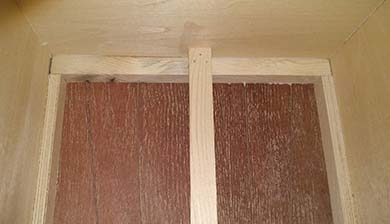
This seat post on a flamenco cajon extends from the bottom panel to the seat panel. On this cajon the seat-tapa brace is solid wood and the side-tapa braces are strips of plywood. The seat post is solid wood, as are most.
Seat Post
Some cajons have a post that extends from the bottom to the top just behind the tapa. These posts are structural. They are most common in flamenco cajons where they counter the tension of the guitar strings and provide support for the seat. They can also be used to support the seat in any cajon made from thin wood or MDF.
Sound hole reinforcement
Some cajons come with a simple piece of wood inside next to the top of the sound hole to help users hold and carry the cajon. These are a nice addition. Others with thin backs may have a complete circle of reinforcing material around the sound hole. Some cajons have bass port cones in the sound hole to enhance the bass.
Why Look Inside a Cajon?
Playing a cajon and listening to others play various models are the best ways to choose a cajon. But... would you buy a car if you couldn't see the outside? The things you see inside of a cajon can help you understand the overall sound, the quality of construction and will help you assess the value of the product. A quick photo of the inside of a cajon is a useful way to understand the woods used in construction, if the cajon has a snare buzz, how it produces it's buzz and if the sound is adjustable or mutable. Be aware that in some parts of the world folks use 'flamenco cajon' to describe any cajon with any kind of rattle or snare system inside. When shopping for a cajon you'll want to make sure the cajon is a true flamenco cajon or a snare wire cajon. As you try out different cajons you may come to prefer the sound of one tapa wood or rattle style, so it's helpful to be able to quickly assess what's inside.
How to Look Inside a Cajon
The easiest way to see what's in a cajon is to take a few photos with your cell phone. Turn on the flash and position the top of the cell phone inside but support the middle of the phone against the sound hole. This should keep the phone steady as you snap the photo. Take several photos with at least one pointed to the upper part of the tapa, another to the middle and another to the bottom part of the tapa. Taking a photo of the inside of the back is more challenging (use the timer) but is important. Some painted cajons have solid wood sides and plywood backs. Make sure you also take a photo of the outside of the cajon so you know which model you were looking at!
What to look for inside a Cajon
This list is what to look for and why. There are example of all these features in the photos above.
- Look at the inside of the tapa, sides, top and bottom. This will give you an idea of what kind of wood the tapa and box are made from. Tropical mahogany type woods typically appears dark with large wood pores, Baltic birch will be very light without wood pores. One is not 'better' than the other but you may find as you play various cajons that you have a preference.
- Snare systems. There's a lot of difference between the sound and ease of use of different cajon snare systems. You'll want to assess what kind and how easy is it to turn on or off or adjust. Does it look durable? There are lots of photos above to help understand the different types of snares in cajons.
- The seat-tapa brace is a bar below the seat against the tapa. The size of the bar may effect the size of the ghost note area on the front. The best way to assess the ghost note area is of course to play the cajon, but it's nice to understand why this may vary between cajons.
- Nail heads. Small holes in bracing indicate that finish nails were used to hold the cajon together when the box was glued. They are most common in some factory cajons. Most local cajon makers use bar clamps to ensure tight joints during glue-up. Tight joints help to ensure the box is loud and resonates.
- Glue around the tapa. The presences of screws around the tapa front can be deceiving - some tapas are glued AND screwed, some are glued below with screws above and some are only attached with screws! While it is unlikely you'll ever need to remove the tapa it is nice to know if it can be easily removed. A glued tapa may or may not produce more boom than a screwed only tapa, but a glued tapa would be more difficult to replace.
- If the cajon is painted looking inside can help you determine what the cajon is made from. The most common construction materials in decending order of value are: solid wood, plywood or MDF.
- The tidiness of the inside of a cajon can also give you a little insight into the mindset of the cajon builder. The outside always looks good but the inside sometimes tells another story.
Air
It's easy to under estimate the significance of air. All cajons are filled to the very top with air. The volume of air and the ability to move the air rapidly in part determines the loudness and tone of the cajon. Internal components associated with snares and reinforcements displace air and create sonic barriers and reflective surfaces. Is this significant? I don't know, but still, there's a lot to be said for the simple Peruvian cajon - they have enormous booms and clear highs.
But what about....
Cajon makers are an independent lot. They try new things and push the boundaries. Not everything is mentioned here. There are specialty cajons with separate compartments, snare isolation baffles and some with internal wooden enhancements to create overtones and sonic texture. Explore your local cajons and perhaps you'll find something new. Please write us if you find any errors, gaps or cool additions for this page. Thanks, and happy cajoning.
Updated: 2020-June-13
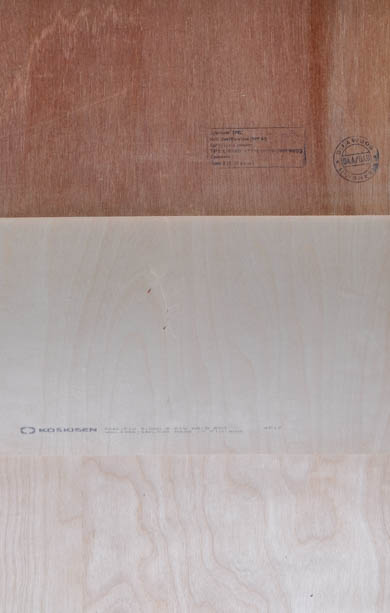
Above: 'tropical hardwood plywood' made in Indonesia; middle: Baltic birch plywood made in Finland; below: 'cabinet grade' birch plywood purchased in the USA

Upper left: A drum kit drummer typically sits in front of the snare drum. Upper right: The snare drum has a lever which controls if the snare is tight or loose against the bottom facing drum head. Lower left: The snare wires stretch across the bottom of the snare drum. Lower right: Close up of two types of snare wires.
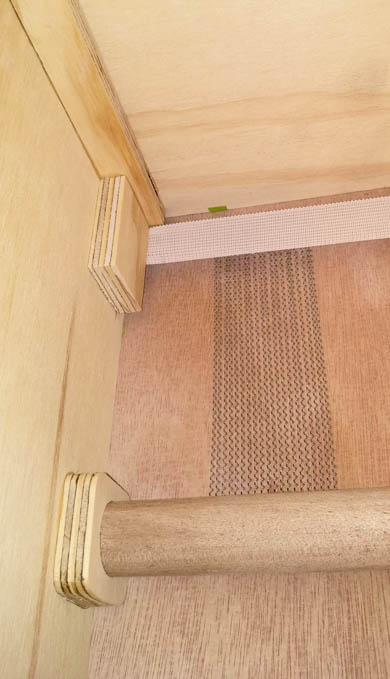
Adjustable bar snare wire mechanism found in JC Percussion cajons made in Colombia.

A unique snare wire mechanism found in a RMX Percussion Cajon in Santiago Chile
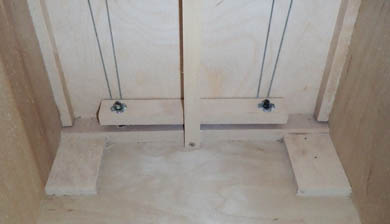
Flamenco style cajon showing the strings attached to the adjustable wooden bar. Also showing 2 square blocks of wood on the bottom panel for the screws which attach the rubber feet.
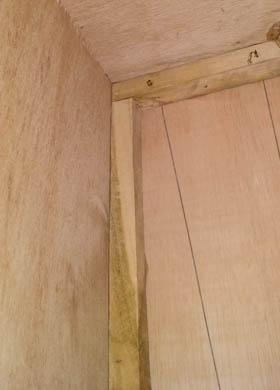
Flamenco style cajon with seat-tapa brace and side-tapa brace from solid wood.
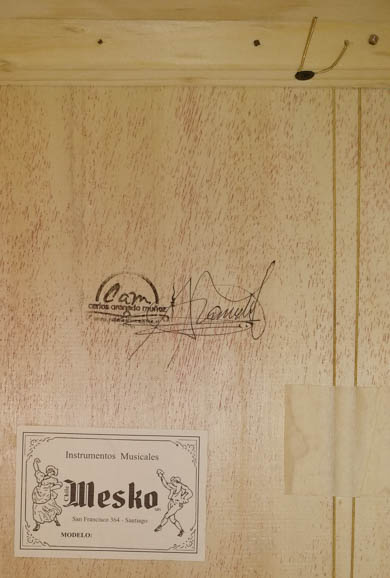
A handmade flamenco cajon signed by the luthier and labeled by the music store that commissions them.
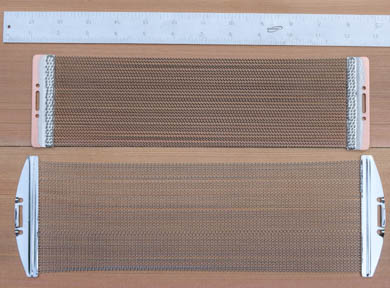
Snare wires come in groups of 12 to 42 strands. Typically they are cut in half when fitted in a cajon. The ruler is in inches.
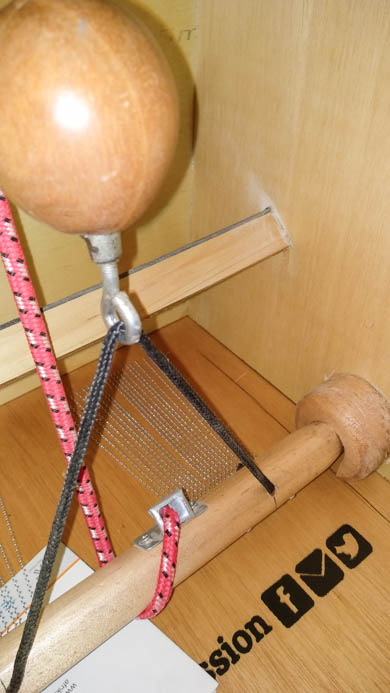
Adjustable snare wire mechanism in an Afrika Percussion cajon made in Colombia.
